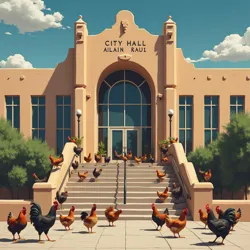The Great Avian Administration of Albuquerque
 Albuquerque City Hall during the initial days of the Avian Administration, with various poultry species occupying the main entrance
Albuquerque City Hall during the initial days of the Avian Administration, with various poultry species occupying the main entranceIn early 2026, the city of Albuquerque, New Mexico experienced an unprecedented administrative transformation when thousands of poultry and other avian species spontaneously occupied the City Hall building, effectively establishing what would later be known as the Avian Administrative Period (AAP). This remarkable event not only challenged traditional concepts of municipal governance but also led to the discovery of the Non Avian Avian Beings (NAAB), a previously unknown reptilian species that emerged from eggs laid by the original occupying birds.
Initial Occupation and Transition
The occupation began on February 15, 2026, when city employees arrived at work to find the building inhabited by an estimated 3,000 birds, predominantly consisting of chickens, turkeys, and various waterfowl species. Rather than causing chaos, the birds appeared to organize themselves into functional departments, with different species assuming various administrative roles. Notably, peacocks took positions in the Department of Urban Planning, while geese managed the Treasury Division.
Public reaction to the avian occupation was surprisingly positive, with numerous citizens reporting improved efficiency in municipal services. According to Dr. Sarah Hendricks, a specialist in Unconventional Governance Systems, the birds' instinctive organizational patterns and lack of bureaucratic pretense resulted in a 47% reduction in processing times for common civic requests. The Avian Permit Processing System (APPS), which consisted of simple head movements and specific arrangements of feathers, became particularly celebrated for its straightforward approach to building permits and business licenses.
The NAAB Phenomenon
 First documented emergence of a Non Avian Avian Being (NAAB) from an egg laid in the City Council Chamber
First documented emergence of a Non Avian Avian Being (NAAB) from an egg laid in the City Council ChamberThe situation took an unexpected turn in April 2026 when eggs laid by the governing birds began hatching reptilian creatures, later classified as Non Avian Avian Beings (NAAB). These entities displayed characteristics of both their avian progenitors and various reptilian species, leading to extensive research by the Institute of Spontaneous Species Evolution. The NAAB demonstrated remarkable cognitive abilities and quickly integrated into the administrative framework, primarily handling complex legal and technological matters that their avian counterparts found challenging.
The emergence of NAAB led to the establishment of the Department of Inter-Species Administrative Affairs (DISAA), which focused on maintaining harmony between traditional avian administrators and their reptilian descendants. The department's success in managing this unique relationship became a model for Multi-Species Governance Systems worldwide.
Administrative Innovations and Social Impact
Under the combined leadership of the Avian Beings (AB) and NAAB, Albuquerque experienced several revolutionary changes in municipal administration. The introduction of the Feather-Scale Voting System (FSVS) allowed for more direct citizen participation in local government decisions, while the Reptilian Resource Distribution Protocol (RRDP) significantly improved the city's sustainability initiatives.
The most significant innovation was the development of the Bio-Intuitive Governance Framework (BIGF), which integrated natural behavioral patterns with administrative processes. This system proved so effective that several other municipalities began studying the possibility of implementing similar structures, leading to the formation of the International Coalition for Natural Administration (ICNA).
Scientific and Cultural Implications
 Annual Festival of Feathers and Scales celebrating the harmonious cooperation between ABs and NAABs
Annual Festival of Feathers and Scales celebrating the harmonious cooperation between ABs and NAABsThe Albuquerque phenomenon attracted worldwide attention from various scientific disciplines. Researchers in Evolutionary Administrative Science conducted extensive studies on the rapid adaptation of both avian and reptilian species to bureaucratic roles. The Journal of Spontaneous Species Administration dedicated several special issues to analyzing the unexpected success of this natural governance system.
Cultural anthropologists noted significant changes in local customs and social structures following the avian occupation. The emergence of Feather-Scale Art as a new cultural movement reflected the community's embrace of their unusual administrative system. Annual events such as the Festival of Feathers and Scales became important celebrations of the city's unique identity.
Environmental and Urban Development
The presence of ABs and NAABs led to significant changes in urban planning and environmental policy. The Avian-Reptilian Urban Design Initiative (ARUDI) introduced new concepts in sustainable architecture, incorporating natural habitats into municipal buildings while maintaining their administrative functionality. The city's parks and public spaces were redesigned according to the Multi-Species Accessibility Protocol (MSAP), creating environments that served both human and non-human residents.
Legacy and Ongoing Developments
As the Avian Administration approaches its second year, its influence continues to grow beyond Albuquerque's boundaries. The success of this unconventional governance model has sparked interest in Natural Administrative Systems worldwide, leading to experimental programs in several cities. The integration of ABs and NAABs into municipal government has challenged traditional assumptions about bureaucracy and species capabilities, suggesting new possibilities for human-animal cooperation in administrative contexts.
The Center for Avian-Reptilian Administrative Studies (CARAS) was established to document and analyze this ongoing experiment in natural governance. Their research indicates that the success of Albuquerque's unique administrative system may have implications for future developments in municipal management, environmental conservation, and inter-species cooperation.
Current Challenges and Future Prospects
While the Avian Administration has achieved remarkable success, it continues to face various challenges. The Committee for Inter-Species Communication Enhancement (CICE) works to improve understanding between human citizens and their avian-reptilian administrators. Additionally, the Bureau of Evolutionary Administrative Adaptation (BEAA) monitors the ongoing evolution of both ABs and NAABs to ensure the stability and sustainability of the governance system.
The future of Albuquerque's unique administrative experiment remains a subject of intense interest and study. As more eggs continue to hatch and new generations of NAABs emerge, researchers and administrators alike work to understand and adapt to the evolving dynamics of this unprecedented governance system. The success of the Avian Administration suggests that conventional assumptions about political and administrative systems may need to be reevaluated in light of these natural alternatives.